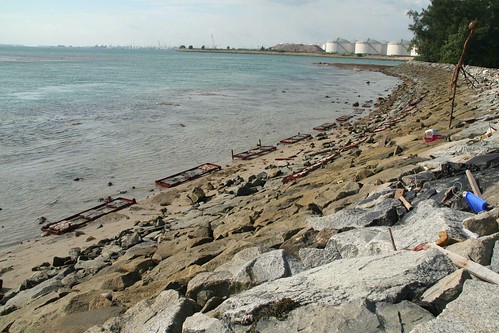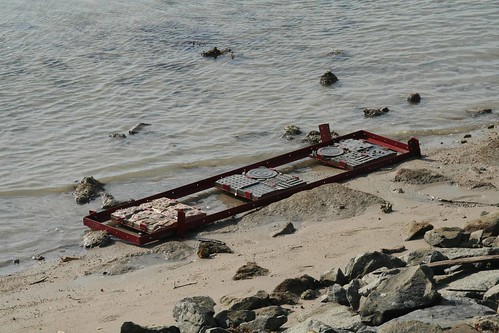Hantu Island an experimental site for costal protection design
 November 24, 2009
November 24, 2009
Designing innovative coastal protection using ecosystem-based approaches
By Peter Todd

Increasing urbanisation in Singapore has resulted in extensive replacement of natural habitats with man-made habitats. A good example is the artificial seawall, that has becomes a ubiquitous feature of the coastline. Being vertically very steep, and structurally quite simple, this compressed intertidal region represents a very stressful habitat that does not support the kind of diversity expected at the seashore. One explanation for the paucity of life on seawalls is the absence of a wide range of microhabitats. The aim of this study is to test whether complex concrete tiles attached to seawalls can enhance their biodiversity. Understanding how to improve the value of seawalls as surrogates of natural habitats is important for intertidal biodiversity conservation on modified shorelines.

The tiles are arranged in blocks of three that comprise a “simple” tile (all sizes, spacing, and depths equal), a “complex” tile (sizes, spacing and depths variable, but with the same mean values as the simple tile), and a “control” (the same material as the seawall: granite). The blocks are attached to steel frames that in turn are fixed to the seawall or substrate. Eight frames have been arranged at 1.3m below the high tide mark (the “intertidal” set), there are also another eight frames fixed to the substrate at the foot of the seawall (the “subtidal” set). They will now be left in place for a few months while colonisation is monitored. At the end of the experiment, all the tiles and frames will be removed.
 This project is funded by the Singapore-Delft Water Alliance (SDWA) and is part of a larger endeavor to improve biodiversity on Singapore’s seawalls. The Principle Investigators are Dr Peter A. Todd, Marine Biology Laboratory, Department of Biological Sciences, NUS and Dr. Tjeerd J. Bouma, Netherlands Institute of Ecology, Centre for Estuarine and Marine Ecology. This particular stage is being led by one of Peter’s Honours students, Lynette Loke, who designed the tiles and played a major role in their construction and deployment. The frames were fixed in place from land at very low tide and involved a lot of lugging materials and tools from the jetty to the site (e.g. each tile weighs about 15kg and there are 48 of them)!
This project is funded by the Singapore-Delft Water Alliance (SDWA) and is part of a larger endeavor to improve biodiversity on Singapore’s seawalls. The Principle Investigators are Dr Peter A. Todd, Marine Biology Laboratory, Department of Biological Sciences, NUS and Dr. Tjeerd J. Bouma, Netherlands Institute of Ecology, Centre for Estuarine and Marine Ecology. This particular stage is being led by one of Peter’s Honours students, Lynette Loke, who designed the tiles and played a major role in their construction and deployment. The frames were fixed in place from land at very low tide and involved a lot of lugging materials and tools from the jetty to the site (e.g. each tile weighs about 15kg and there are 48 of them)!
The study is a good example of how much fun (!), and interdisciplinary, marine biology can be; from the ecological underpinnings (simple vs complex habitats), the use of algorithms to design the tiles, converting those designs into CAD/CAM drawings that were then used to CNC mill the “master” tiles, which in turn were used to make rubber molds that the concrete tiles were cast from. Sourcing the materials and building the granite control tiles; designing the steel backing plates and frames and their mountings; and organising the permissions, workforce, boats and all the other logistics of the deployment. Of course, there is also a strong experimental design and statistical foundation to the study; there are a number of reasons why there are 48 tiles, each further divided into four designs, and why they are fixed to the seawall in the way they are. Finally, back to the biology, there will be plenty of identification and quantification of the organisms that come and inhabit the tiles.
 Posted in
Posted in 



 content rss
content rss
March 15th, 2010 at 3:11 am
[…] The low tide exposes the reef recruitment experimental set up anchored onto one of the sea walls and reef flats at Hantu. Read more about the experiment here. […]